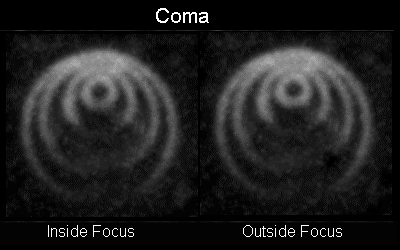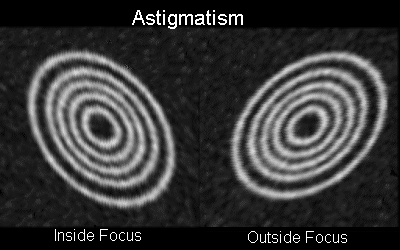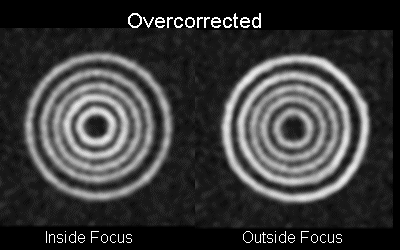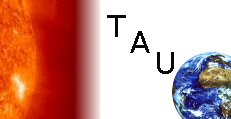This page last modified 1998 November 14
Basic Star Testing
Introduction
These notes relate to reflectors with central obstructions (Newtonian, Cassegrainian, etc). They are not intended to be comprehensive; if you want more detail, get hold of H.R.Suiter's excellent Star Testing Astronomical Telescopes
Performing the test
Firstly, you need to wait until the atmosphere is reasonably still -- if seeing is lousy, it is more than a little difficult to interpret what you see (more on recognising bad seeing later, although the obvious first check is to see if the stars are twinkling/scintillating with naked eye, then check with binocs). Let your telescope reach thermal equilibrium with the outside air. You need to remember that the entire optical system between the star and your brain includes the atmosphere and your eye, as well as the telescope.
Use an eyepiece which gives a magnification in the region of 75x to 150x and focus the chosen star (if you don't have a driven telescope, use Polaris if you live in the northern hemisphere).
Can you get it to snap to a pinpoint image? If not, either seeing is lousy or there is something wrong with the telescope (could be optics or collimation thereof). You may be able to see rings around the focussed image -- this is not unusual.
Rack/turn the focuser a little inside and outside focus. The star image appears to become a larger disk which, on closer examination, is actually a dark "hole" surrounded by rings. (How close an examination depends on the optical system -- with good skies, optics, and eyes the rings are immediately very obvious.) In a perfect telescope, the rings will be identical inside and outside focus.
Once you have learned to see these rings, repeatedly move quickly from one to the other (i.e. inside to outside focus) and back again -- this has a similar effect to a blink comparator and will more easily enable you to see differences.
Interpreting what you see
Perfect System
A perfect system shows a series of rings of equal brightness.

Tube currents
If you see a wobble in the extrafocal image, or if it has an irregular sort of blobby turbulent appearance, it is probably tube currents in the telescope -- you need to wait until it settles down.
Atmospheric turbulence
If it looks a bit like you are watching the river-bed through a flowing river, it is atmospheric turbulence, i.e. bad seeing. The difference between what you see with tube currents and with atmospheric turbulance is that the "ripples" from the atmosphere tend to move in the same direction. You will probably need to wait until the atmosphere is less turbulent.
Coma
Coma will exist in any non-spherical (e.g. paraboloidal) primary mirror. Unless your scope is properly collimated you may see coma at the centre of the field; i.e. star images which appear as mini comets. They "point" towards the optical axis of the instrument. The intra- and extra-focal images show the rings as brighter on one side than the other. The obvious thing is to collimate properly, so that a star in the centre of the field shows no coma.

Astigmatism
Astigmatism shows as elliptical rings -- the orientation of the major axis of the ellipse moves through 90 deg between intra- and extra-focal images. Their actual orientation in the eyepiece may vary from that shown in the drawing.

Undercorrection
An undercorrected mirror has a bright outer ring inside focus and a bright inner ring outside focus.

Overcorrection
An overcorrected mirror shows the reverse of the above -- there is a gradation of brightness through the rings.

Turned edge
If you have an extrafocal image which has a bright outer ring (as does an overcorrected mirror) which is significanly brighter than the next one (i.e. not a gradation of brightness through the rings), you probably have a turned edge. The intrafocal image will not show a change in brightness and the outer ring appears fuzzy.

Further reading
That's a brief description -- learning to interpret what you see is obviously crucial. There is an easily understandable introduction to it in Richard Berry's Build Your Own Telescope (Chapter 11), which is adequate for most amateur purposes. If you really want to get into it in depth, H.R.Suiter's excellent Star Testing Astronomical Telescopes is the acknowledged "bible" on the subject.


